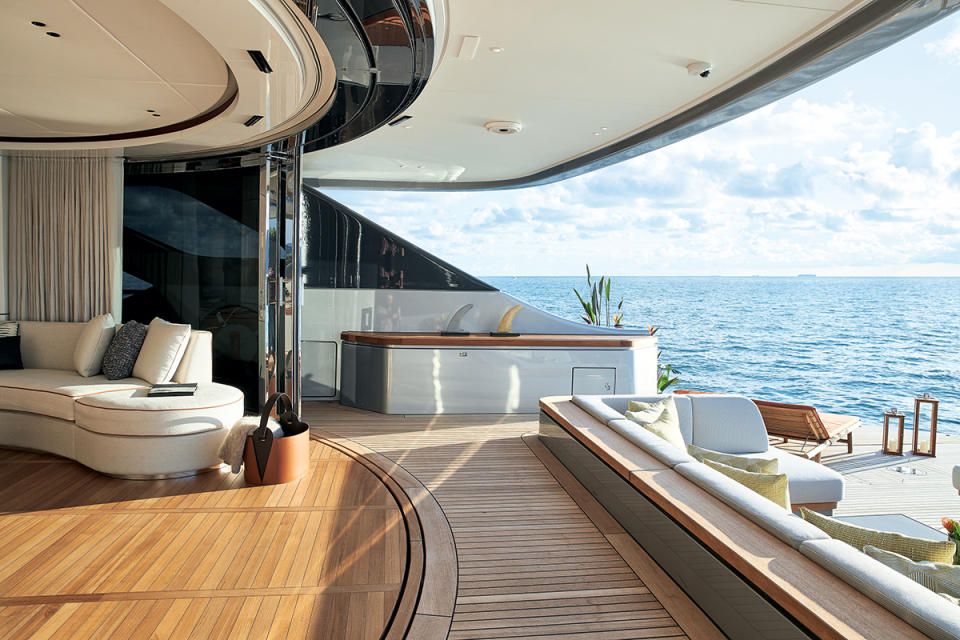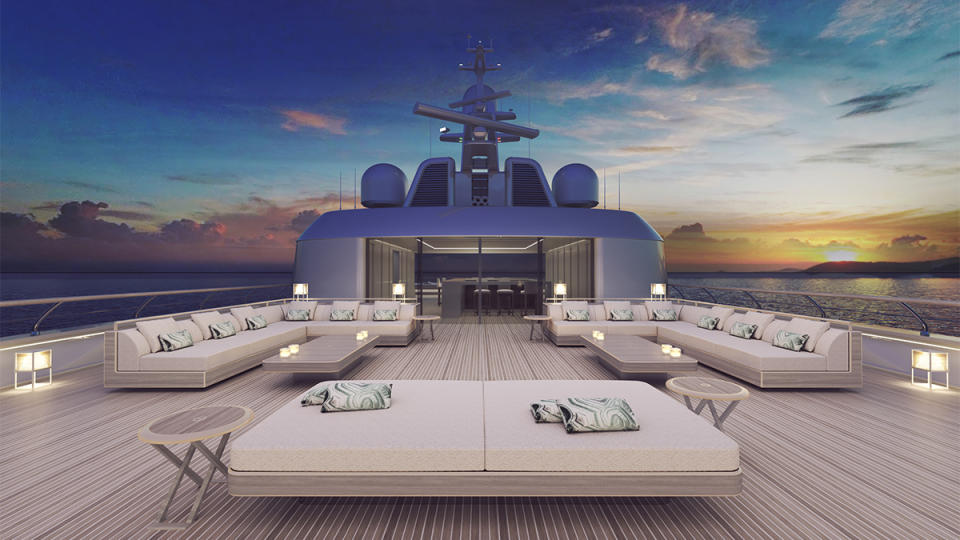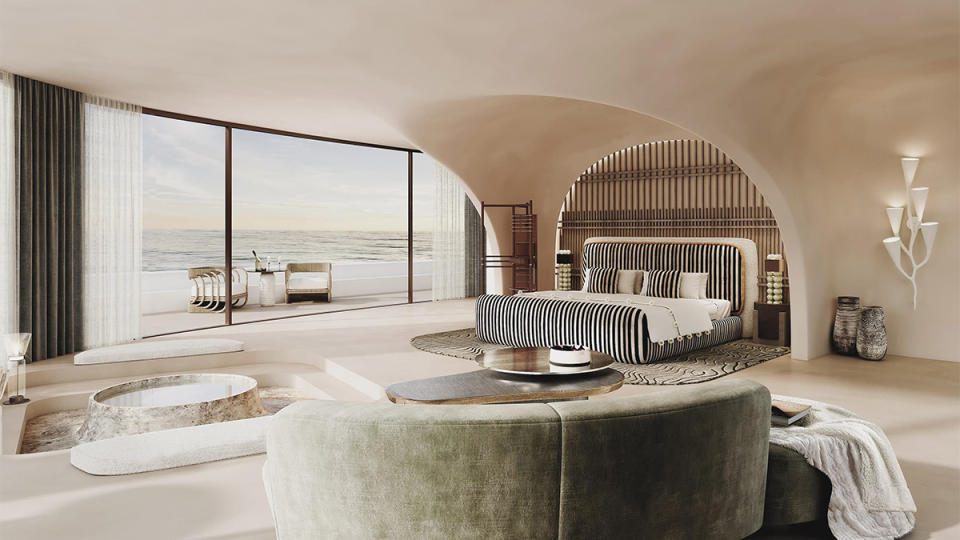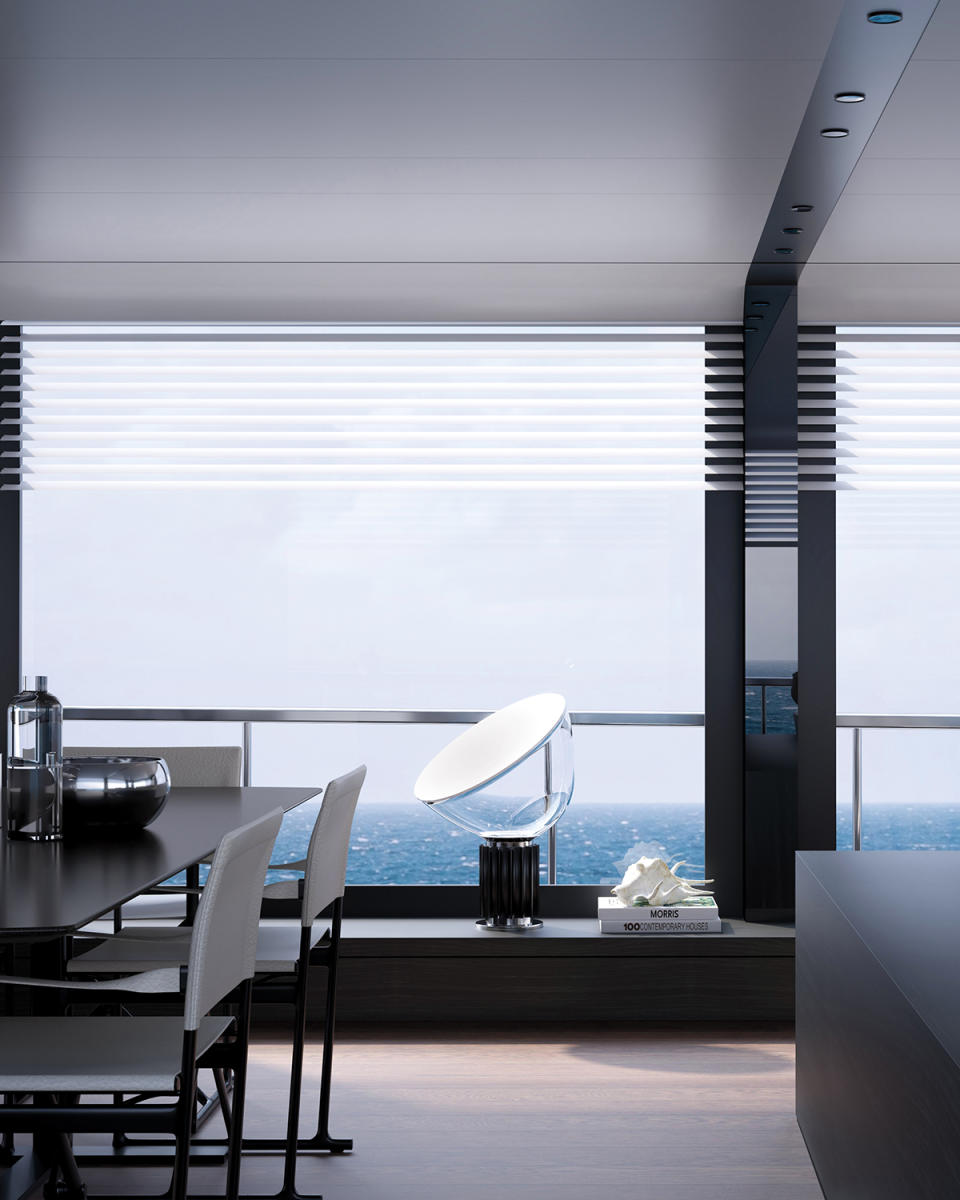Architects and Fashion Designers Are Penning Yachts, and It’s Changing How They’re Made

- Oops!Something went wrong.Please try again later.
- Oops!Something went wrong.Please try again later.
- Oops!Something went wrong.Please try again later.
Pleasure yachts were once the province of amateur sailors and oligarchs—men who, aside from a shared appreciation of varnished teak, adhered to diverging aesthetic templates. For serious mariners, form followed function, and fripperies were frowned upon. The upper-cruster aboard his gin palace, meanwhile, preferred nightclub chic, with heavy doses of gold, chandeliers, and black-lacquered surfaces. Both types of vessel suffered from a surplus of wood paneling and a scarcity of sea views.
That design rulebook has now been thrown out, thanks to shifting priorities, new technologies, and the pandemic-fueled boom in yacht ownership. A rising generation of younger owners prefers watersports toys and wellness suites over cigar lounges and book-matched mahogany. Seductive superyacht concepts on social media promise a life in which families waft unbounded through fluid, open-plan, indoor-outdoor spaces devoid of clutter and supporting walls.
More from Robb Report
Suffice to say, such experimentation is not typically dictated by dyed-in-the-wool naval architects but comes from a fresh influx of creative outsiders from the land-bound worlds of hotels, private homes, furniture, and even fashion. The designers serving the yacht-owning class of 2024 may be disparate, but they have one thing in common: Boats are not their area of expertise.
For decades, a group of former apprentices of Jon Bannenberg, the godfather of yacht design, dominated the field with their trademark lavish style. Bannenberg, part of London’s “swinging ’60s” creative wave, designed celebrated vessels for the great and the not-so-great, including Malcolm Forbes, Adnan Khashoggi, and Robert Maxwell. Throughout the ’80s and ’90s, his protégés—Andrew Winch, Terence Disdale, and Tim Heywood—catered to the tastes of their plutocrat clientele (think fussy moldings, high-gloss hardwoods, tinkling crystal, and veiny marble), with their brand names adding pedigree to ships and their style seen as the hallmark of opulence.
These designers “made a fortune,” says Giovanna Vitelli, chair of the Azimut-Benetti Group, by some distance the world’s biggest builder, who describes their style as “an institutional interpretation of luxury” dating from a more hierarchical era. “So, when I enter the yacht, I find a formal main salon, and then a big formal dining area, prepared to serve a lot of people,” she says. “I also stay away from the sea” due to privacy concerns, meaning small windows and high, enclosed sterns. This “shouted luxury,” in Vitelli’s words, is now giving way to a fresher, airier, more modern approach driven by a rejection of formalities and a new focus on “the very reason you go boating, which is the sea and nature.”
An embrace of the outdoors was a crucial focus for Norman Foster, one of the world’s most famous architects, whose designs for the 2008 YachtPlus fractional-ownership fleet, though controversial, prefigured some of today’s trends. Foster was perhaps the first outsider to disrupt the industry—“a conservative world” at the time, according to Angus Campbell, a senior partner at Foster’s practice who worked on the project: “You spend all this money, and then you have to look through these tiny little porthole windows; you’re on the sea, but you can’t see out. Why is that? So we looked at creating windows and external space that you can walk around.”
In 2010, Vitelli found herself asking similar questions and decided to hold design competitions specifically for creatives from outside the industry. A successful initial collaboration with architect Achille Salvagni that same year led to a series of partnerships with other architects known for their global portfolios of luxury retail, hotel, residential, and product design, including Lazzarini Pickering in Rome, which did two interiors in the Benetti Motopanfilo line; Matteo Thun and Antonio Rodriguez in Milan, who are producing sustainable designs for the Azimut Seadeck series (the first of which will launch at Salone del Mobile this month); and Bonetti/Kozerski in New York, responsible for the interiors of Benetti’s 40M and 34M Oasis series.

The results upended yachting convention. The traditional, strict divisions between interior and exterior were eroded, with “huge glass, huge doors” and a drop-down stern, recalls Vitelli, referring to Benetti’s pioneering “Oasis deck”—a lowered rear section with wings that fold down to create an expanded beach-club zone.
Other shipyards followed suit. One particularly radical concept was the 2015 Savannah, created for Feadship by Cristina Gherardi, who previously was director of architecture at Dior and designed projects for Armani Casa. The yacht featured multiple innovations, including hybrid propulsion, an engine ventilation that filtered air through tables in the bar, and a partially submerged glass-walled Nemo Lounge for watching passing fish.
Oceanco, a full-custom builder that counts Jeff Bezos and Steven Spielberg among its clients, now works with non-yachting designers under its NXT program, while Amer, a smaller semi-custom brand from the Permare Group, recently partnered with Milan-based architectural studio Palomba Serafini to create the award-winning F100 Glass Cabin. And in 2020, Giovanni Costantino, founder and CEO of the Italian Sea Group (TISG), reeled in the Moby Dick of designers: Giorgio Armani. The fashion maestro, who has owned his own yachts for two decades, not only signed up to create two Armani-branded 236-foot Admiral megayachts, including one launching at the Monaco Yacht Show this year, but also bought a 4.99 percent stake in TISG.

The brand-name appeal of famous designers targets a new type of buyer, one who shops for a yacht as they would a luxury car, says Philippe Briand, a naval architect and creator of racing vessels as well as Vitruvius superyachts. The previous generation “came with sailing experience,” he says, “so they were more aware of functionality and constraints. Today, this generation are newcomers, and they’re consumers. That’s fine, but they need to be a bit educated about how complex it is to create a boat.”
Ownership is expanding and changing. There were 1,203 superyacht projects under construction in 2023, according to the Global Order Book, an annual industry survey. That’s nearly twice as many as a decade prior, and demand looks likely to grow in line with the boom in multimillionaires: The most recent UBS Global Wealth Report predicts that the number of people with over $50 million in assets will rise to 372,000 by 2027, up from 243,060 in 2022.
“In the past, rich people were mainly over 50, and now it’s completely different,” says Antonio Rodriguez, codesigner of the Azimut Seadeck series. “There is a boom of younger rich people, especially in Asia.”
Gregory C. Marshall, a veteran naval architect based in Victoria, British Columbia, says his millennial clients (some are in their 20s) “just don’t seem to be interested in traditional superyacht thinking, ” adding that “they travel with a backpack and surfboards.” They want ships that are “less polished on the outside and a little more ‘How many toys can I pile on?’ ”
But yachts are still status symbols: No one buys a superyacht solely from a love of sailing. “If people like the sea, in general they buy a sailboat,” Rodriguez notes. For grander vessels, clients see no reason not to bring in a famous name with no knowledge of the category “like they use a designer for a house in the city or in the countryside,” he says. “It’s a floating house.”
Roberto Palomba’s vessel for Amer was commissioned by a client for whom he had designed projects on terra firma. “He knew me and he loves my style, so he wanted my style in his yacht,” says Palomba, who had no previous marine experience.
The older generation of owners believed that conventional layouts by established industry professionals locked in resale value; today’s clients are much more comfortable with risk. Concepts aimed at this market include vessels shaped like sharks, the Star Trek Enterprise, and bird skeletons. Oceanco’s NXT offerings include Aeolus, a 430-foot gigayacht with a huge, sculpted primary suite and panoramic windows, and Kairos, which has the cosmic, asymmetric feel of a Tokyo shopping mall.

“It’s a less-formal naval feeling onboard nowadays,” says Paris Baloumis, group marketing director at Oceanco. “Space has become much more fluid.” The aim, he says, is seamlessness between interior and exterior, work space and private space. “Back in the day, you had a special area for aperitifs, maybe a cigar lounge. A lot of different spaces dedicated to specific functions.” In contrast, Oceanco’s NXT Tank concept has replaced rooms with three amorphous zones.
Much of the work of external designers involves removing clutter. Giorgio Armani tells Robb Report that his blueprints were inspired by the clean lines of military vessels “and the optimization of space characteristic of old ships—away with all the infrastructures that can normally be seen, such as the tenders.”
Inside his Admiral yacht for TISG, windows feature sliding panels to help create “spacious interiors flooded with natural light,” he says. “The sensation is wide-ranging and of total immersion in the surrounding environment.” The effect, enhanced by the stealth-wealth decor, recalls his relaxed yet deceptively decadent suits.
Touring yachts as part of his research for the Oasis series, Enrico Bonetti, of Bonetti/Kozerski, found the interiors “very stiff, rigid, with furniture where nobody would sit” while also prioritizing “something flashy here, something else flashy over there. So what we tried to do is to link all the spaces together and have a continuation of materials and textures and colors.” The aim, he says, is nonchalance: “sophisticated but without showing it too much.”
The main difference between the old and the new is a shift away from ostentation and toward a discreetly refined simplicity. Rodriguez’s mantra is “Always remove.” Instead of a bunch of gold and marble, he says, “we try to do the opposite, to keep only the materials you need, and never, never to show off.” He calls this approach the new luxury.
Technology is also altering the design process. Engineers at Azimut-Benetti no longer make test models, instead using Oculus virtual-reality glasses to “walk” around the boat, making adjustments in real time. “The ability to do large, technical, structural glass has evolved enormously,” says Marshall, whose studio produced the Artefact superyacht, which may lay claim to more glass than any other yacht on the water and won two major awards at the 2021 World Superyacht Awards. Technological advances engender new ideas, he says. “You start to think, ‘Well, if the glass is actually stronger than my aluminum structure, why would I make it out of aluminum and not glass?’ ”
Sustainability is another driver of change. For the interiors of Azimut’s Seadeck, Rodriguez says he selected exclusively recycled or recyclable materials, including a carpet made from discarded fishing nets, which Vitelli describes as “pleasant to touch.” She adds, “You don’t have that cold plastic effect—it’s like silk.”
Change isn’t always welcomed by the technical teams who have to turn outsiders’ nautical fantasies into seaworthy vessels. “I’ve seen a lot of examples of yachts which have been controlled by the interior designer, and in the end [it] does not hang together,” says Philippe Briand, the naval architect, who prefers to work only with marine-specific interior designers.
We were trying to push the boundaries and create a better experience for the guests, rather than make it easy to tie up when you’re trying to bring it into shore.– Angus Campbell
He particularly abhors the proliferation of unrealistic concepts on social media: “They’re all fake, to be honest, because they’re not representing any existing boat—they’re only the dream or the marketing of a young designer.” Moreover, these renderings are “polluting the market,” he says, because they give clients improbable expectations. “The client says, ‘You’re creative, you’re inventive, so I’m going to order a boat from you [only] if you’re able to do the same design I saw.’ Which puts us in a very difficult situation.”
Briand cites the trend for ultralow beach clubs, which he calls unfeasible in even slightly choppy water. “To make an attractive image in a magazine,” he says, the rendering needs to be “flat, all open, two feet above the water—and, of course, on the rendering, the water is [also] flat. It’s not corresponding to any real functionality. I mean, it’s basically fashion.”
Marshall, the Artefact’s architect, agrees that clients often bring concepts that are impractical but usually finds that, with “some minor adjustments,” the designs are “buildable without losing the aesthetic inspiration.” He says it largely depends on the purpose of the yacht, with an oceangoing vessel requiring more serious engineering than a Monaco posing platform—not every model needs to be able to “survive a hurricane in the middle of the Atlantic.”
Marshall likewise welcomes the creative tension inherent in a meeting between external creatives and in-house engineers. “We look at it like a war,” he says, cheerfully. “Because the reality is each discipline is in conflict with the other disciplines. You may love the styling, but the structural people go, ‘Thanks, how do I build that?’ ” The way he manages the mediation process is to “start with the concept, go to a certain point and stop, then do a structural pass, then do a mechanical pass, [then] go back to styling—and the stylists of course look at it and go, ‘Oh, my gosh, all these engineers just slaughtered my brilliant design.’ And we go round and round.” The conflict is the point, he says. “When you get the balance right, then it’s a good design.”
Baloumis agrees but admits to “frustrations on both sides.” Outsiders lack “the technical understanding of naval architecture,” at which point “we have to really guide [them] to understand why certain things are not possible. But on the other hand, it also pushes us to see how we can make it work. And that is a nice interaction.” This Darwinian-esque struggle is necessary, he says, “because the yachting industry is quite confined, quite closed.”
Palomba and Bonetti both encountered resistance to their initial ideas for Amer and Benetti, respectively. According to the former, he had to “force the producer to create big windows,” while Bonetti recalls continually clashing with what he refers to as “the rules,” such as having an elaborately set but unused dining table in the main salon. “For us, not knowing the rules [made it] easier to do things a little bit differently.”

That often fruitful tension between outsiders and insiders can tip out of balance in the presence of what Marshall calls a forceful stylist. He’s happy to incorporate “round windows, triangular windows, giant staircases,” as long as the vessel operates as more than a stage set.
One veteran yacht designer, asking not to be named, points to Foster’s YachtPlus as an example of form outweighing function. “It just didn’t function as a boat that well, in terms of the normal day-to-day things, like simply tying it up. A lot of the aesthetic inspiration that non-boat people come up with is very clever, but if it doesn’t meet the core usage, it doesn’t last very well.”
Campbell, of Foster + Partners, says that their brief was innovation and readily admits that they prioritized eye-catching radicalism over the nitty-gritty of nautical functionality. “We were trying to push the boundaries and create a better experience for the guests,” he says, “rather than make it easy to tie up when you’re trying to bring it into shore.” Those choices, he says, are often in direct contradiction, adding, “I think what happens with a lot of yachts is that the crew take a lot of the key spaces. And the fact is that the guests who’ve paid for the yacht get all the spaces that are left over. We did question a lot of those items to try and push it because, you know, how [else] do you get innovation?”
Maritime regulations often curtail the ambitions of owners and designers. A client’s desire for double-height ceilings is hard to square with fire regulations, which limit the number of open spaces. “A boat is not a bag, it’s not a dress,” says Vitelli. “There’s a lot of substance—you’re buying a floating object full of technology, so [safety] has to remain the priority.”

In terms of interiors, most still agree that the nautical nature of a yacht should be reflected in its fixtures and fittings. “A boat should remain a boat and should remain marine,” says Vitelli, adding that she rejected some architect proposals that were too close to “a New York loft.” Bonetti also cautions against mimicking residential styles too closely. “We’re seeing some boats that if you [replaced] the view from the windows with a street, it could be an apartment in the center of Berlin,” he says, adding that vessels can reflect their authentic purpose “without going back to the old mahogany interiors.”
But exactly how should a yacht’s design convey its marine essence? It’s partly a matter of safety, says Vitelli: It must have “rounded shapes,” because no one wants to encounter a sharp corner in a storm; handrails and non-slip floors are also crucial. But for a superyacht, it’s also a matter of luxury aesthetics—which means bespoke built-in furniture. Anything off-the-peg “is not perceived as top luxury by certain customers, it’s luxury that we can more or less all afford to buy—Poltrona Frau or Minotti.” In other words: mass luxury.
If the glass is actually stronger than my aluminum structure, why would I make it out of aluminum and not glass?– Gregory C. Marshall
Bonetti agrees. “The majority of the furniture and the millwork should be specifically designed for that boat,” he says. “It shouldn’t be something from a showroom.” Palomba, however, prefers “movable pieces from brands like B&B and Talenti,” specifically to get away from “integrated fixed furnishings,” which for him are too redolent of the molded-fiberglass fixtures of yesteryear.
When is a boat not a boat? When it is, in Armani’s words, “a moving house, with particular characteristics.” Today’s owners employ residential architects precisely in order to create the feel of a floating home. Such personal designs will inevitably conflict with the mathematical certainties of naval engineering. But the best shipyards welcome outsiders who bring the friction that sparks creativity—such open-mindedness is especially necessary as technology continues to expand what’s possible. Yacht design is not “an ever-fixed mark / That looks on tempests and is never shaken,” as Shakespeare might have it, but instead it must trim its sails to the prevailing wind.
Best of Robb Report
Sign up for Robb Report's Newsletter. For the latest news, follow us on Facebook, Twitter, and Instagram.

